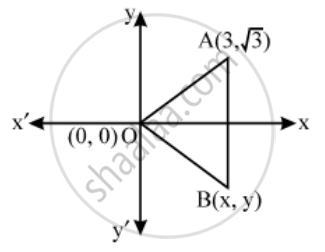Advertisements
Advertisements
प्रश्न
If two vertices of an equilateral triangle be (0, 0), (3, √3 ), find the third vertex
उत्तर
O(0, 0) and A(3, √3) be the given points and let B(x, y) be the third vertex of equilateral ∆OAB. Then, OA = OB = AB
`⇒ OA^2 = OB^2 = AB^2`

We have,
`OA^2 = (3 – 0)^2 + (√3 – 0)^2 = 12,`
`OB^2 = x^2 + y^2 and, AB^2 = (x – 3)^2 + (y – √3)^2`
`⇒ AB^2 = x^2 + y^2 – 6x – 2 y + 12`
`∴ OA^2 = OB^2 = AB^2`
`⇒ OA^2 = OB^2 and OB^2 = AB^2`
`⇒ x^2 + y^2 = 12`
`and, x^2 + y^2 = x^2 + y^2 – 6x – 2 √3y + 12`
`⇒ x^2 + y^2 = 12 and 6x + 2 √3y = 12`
`⇒ x^2 + y^2 = 12 and 3x + √3y = 6`
`=>x^2+((6-3x)/sqrt3)^2=12[.:3x+sqrt3y=6:.y=(6-3x)/sqrt3]`
`⇒ 3x^2 + (6 – 3x)^2 = 36`
`⇒ 12x^2 – 36x = 0 ⇒ x = 0, 3`
∴ x = 0 ⇒ √3y = 6
`\Rightarrow y=\frac{6}{\sqrt{3}}=2\sqrt{3}[`
and, x = 3 ⇒ 9 + √3 y = 6
`=>y=(6-9)/sqrt3=-sqrt3 `
Hence, the coordinates of the third vertex B are (0, 2 √3) or (3, – √3).
